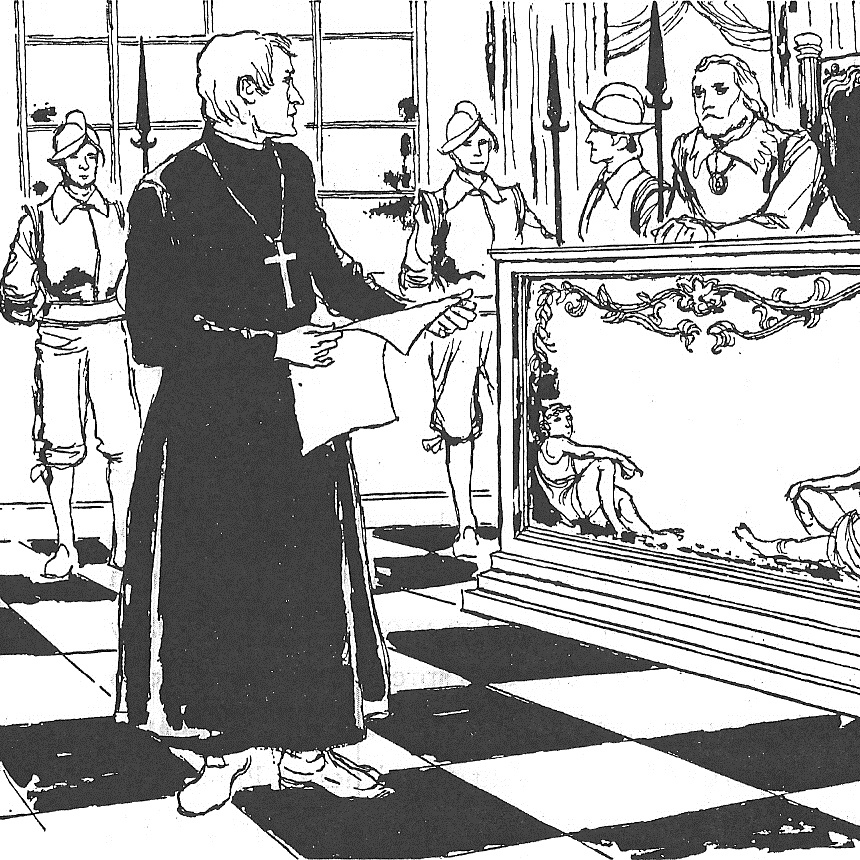Kino - Speaker of Truth to Power
Ride for Justice and Peace Journeys
CORRESPONDING SUBJECT PAGE LINKS: Click on the links below to the corresponding subject pages that presents Kino's 12 year advocacy for the return to The Californias and the history of the Tubutama Uprising and Kino's advocacy in Mexico City. To view the corresponding pages, click Tumacacori page and Kino Ride for Justice History page.
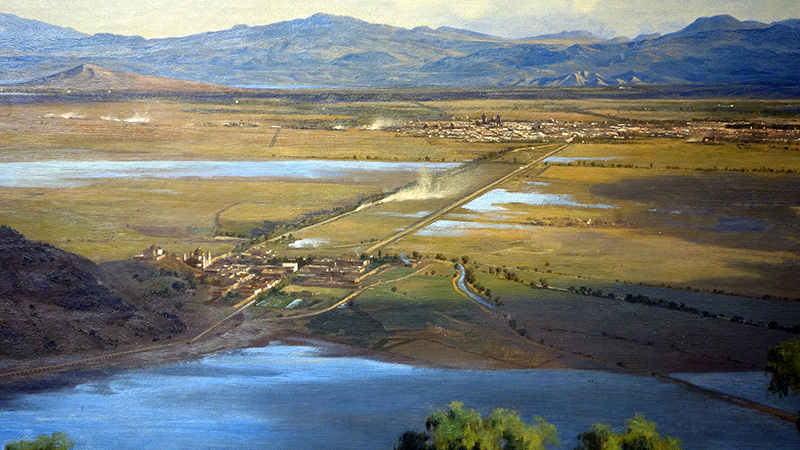
Tepeyac Hill and Mexico City
From El Valle de México Visto desde El Cerro de Santa Isabel 1875
José María Velasco
Weekly Itinerary
Trail Segments and Thematic Accounts
Editor Note: The Weekly Intinerary entries are modified from Facebook posts that were published to correspond to the anniversary dates from the Reconstructed Daily Trail Log that estimates arrival dates at locations as Kino traveled through the diverse natural habitats of Mexico. The text of the Facebook posts were limited to about 130 words. The posts can be repititive so each Facebook post would have the necessary background to be read independently.
Each week of the ride to Mexico City has two entiries. The account entries describe events or themes in Kino's life especially those that relate to Kino speaking truth to power in Mexico City. The trail entries describe Kino's route for a particular week and the diverse natural habitats of Mexico. The routes traveled are based on the article "Camino real de Sonora" by Flavio Molina. The article describes the important history of the El Camino Real between Sonora and Mexico City. The Molina article sets out a log of a trip that was made in 1771. That trip took twice the time as Kino's ride from Mission Dolores to Mexico City..
Kino traveled the El Camino Real whose various segments had different names depending on the trail's location. The "Camino real de Sonora" (also called the "Camino de la Costa") ran between the northern Sonoran frontier and Sinaloa. The "Camino a la Tierra Afuera" ran from Sinaloa to Guadalajara and Mexico City. The segment of the "Camino Real de Tierra Adentro" that Kino rode overlaps with The Camino a la Tierra Afuera. Kino traveled on one of the several routes of Camino Real de Tierra Adentro starting as he passed through Salamanca and then on to Mexico City.
Because the journey required endurance and speed (average 28 miles/ day), it was important for Kino and his O'odham trail companions to follow routes with dependable sources of water and to travel to places where supplies including fresh horses could be provided. Kino's writings about the journey to Mexico City and his return to Mission Dolores are sparse but eventful.
Kino made only one return trip to Mexico City during his 24 year assignment in the Pimeria Alta. Before this last assignment. Kino made many trips between Mexico City and the Pacific coast of Sinaloa and southern Sonora in support of his earlier mission effort in Baja California and its revival.
For history of Kino's Ride click Kino's Ride for Justice and Peace.
For History of Kino's Ride
Click Page
Ride for Justice & Peace History Page
Northern Sonora
Week 1
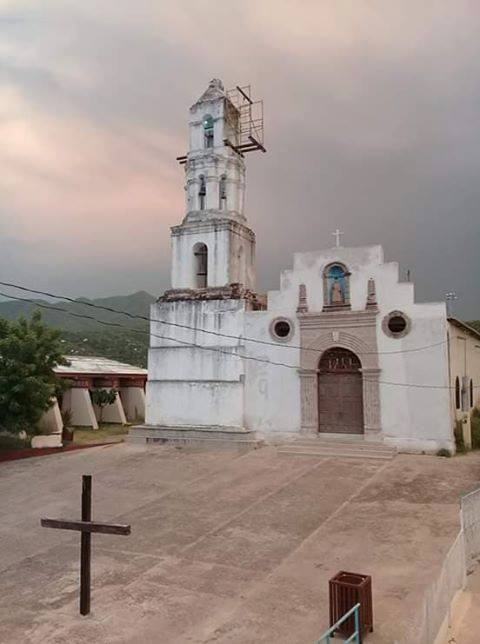
Mission San Ignacio - Onavas, Sonora
Facebook Series on Kino's Ride Begins
Thank you to Isai Lapizco Valenzuela, Cronista de Ónavas, for his post about the historic Mission de San Ignacio de Loyola de Ónavas on the Camino de la Costa royal road. Padre Kino arrived with his O'odham traveling companions, on the second week of his 53 day / 2,400 kilometer (1,500 mile) horseback ride to Mexico City. Appearing before the Viceroy and Royal Audiencia in Mexico City, Kino defended the O'odham people and advocated for the Jesuit return to Baja California. The Facebook series - Kino's Ride for Justice - begins tomorrow on November 16th - the anniversary of the day Kino started his heroic ride from from his Mission Dolores headquarters near Magdalena to Mexico City.
November 15, 2018 ·
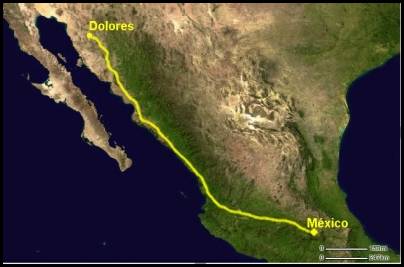
Kino and O'odham Trail Companions Ride 1,200 Miles in 53 Days

On The Trail to Mexico City
Dolores Rideout: Beginning of 1,500 Miles of Trails To Mexico City
Kino and his O'odham trail companions start their 53 day / 2,400 kilometer (1,500 mile) ride to Mexico City on the El Camino Real de la Costa royal road. The journey begins from Mission Dolores near Magdalena on St. Gertrude's Day, November 16, 1695. In Mexico City Kino will appear before the Viceroy & Royal Audiencia to defend the O'odham people after bringing peace to the western Pimeria after the Tubutama Uprising and death of Padre Saeta. Kino will present his "Saeta Biography" where he writes that it "is evident that the treatment of the Natives in the Pimería has been very unjust— leading as it has to mistreatment, torture and murder." A series of posts will follow tracking Kino's Ride for Justice and Peace - the essence of our heroic Padre Kino.
Week 1 Account
November 16, 2018 ·
Submerged Mission and Bell Tower, Batuc, Sonora
Sky Island River Trail Segment
El Camino de la Costa
Camino Real de Sonora
November is the best time to begin a 53 day horseback ride to Mexico City averaging 30 miles per day. The dry season turns the river valleys of the Sky Island mountain ranges from impassable summer torrents to the braided river bed trails of the El Camino Real de la Costa. Northern Sonora Trail (November 16-23, 1695): Mission Dolores departure. South down Rió San Miguel through Cucurpe, Tuape & Opodepe. East through two mountain passes to Huepac and then the mining town of San Juan Bautista (then Sonora's capital) and descending to Oposura (now Moctezuma). South down Río Moctezuma through Terapa, Batuc (now submerged) and Tepupa near the river's junction with the Río Yaquí.
Week 1 Trail
November 17, 2018 ·
Southern Sonora
Week 2
Alamos
Alamos - Protecting the O'odham People From Slavery.
Kino fought against Spanish settlers who relentlessly sought to undermine Kino's mission communities - places of transition where the O'odham would learn how to survive Spanish colonialism. Kino's missions & the Spanish mines were in very close proximity. Kino prevented the plans to develop the mines by enslaving the O'odham & stealing their lands. He traveled north in 1687 on the Camino to begin his work in Sonora through Alamos as its silver bonanza was discovered. Kino was armed with the King's order exempting the O'odham from work levies to the mines. Forty days & 1,200 miles later, Kino will ride from Alamos to the Mexico City capital demanding the order be strictly enforced.
Week 2 Account
November 24, 2018 ·
Tropical Decidious Rain Forest in the Sierra Foothills
Tropical Decidious Rain Forest Trail Segment
Leaving the the Sky Island mountains, Kino enters the tropical decidious rain forests of the Sierra Madre foothills. The dry weather of late November changes back the foothills to it usual desert brown - making barren and transparent the lush green tree canopies from the summer rains. Week 2 Route (November 24-30,1695): Riding southeast. From Batuc down the Rio Yaqui valley through Tepupa, Soyopa (map top center), Tónichi & Ónavas. Leaving the Rio Yaqui and following the Rio Chico up through Movas to its headwaters at Nuri. Up and over the divide to Tezopoco and down the Rio Cedros through Tepehui to Conicari at the Rio Mayo crossing. Overland to the booming mining center of Cuidad Alamos (lower right) - see additional Week 2 post about Alamos.
Week 2 Trail
November 24, 2018 ·
Northern Sinaloa
Week 3
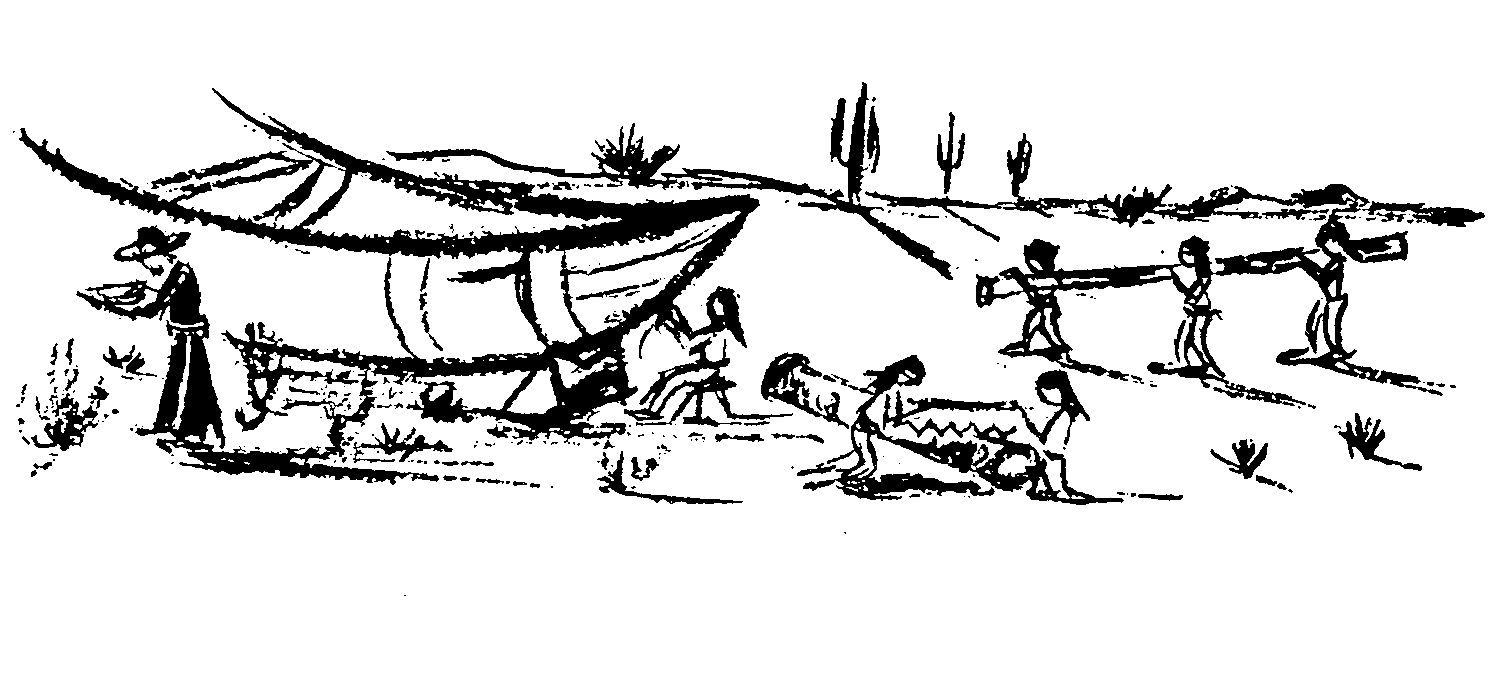
Kino's Boat in the Desert & Ships at Sea by Artist Ted DeGrazia
Advocating Jesuit Return To The World's Largest Island For The Most Destitute.
Kino never forgot the native people of Baja, the world's poorest. He ministered to them for 3 years as part of the ill fated Atondo Expedition that ended in 1685 over his objections. Kino also worked tirelessly in Sinaloa's tropical coastal plains. It was the mainland base for Baja. Kino celebrates the Feast of his patron saint Francis Xavier in Nio where Atondo's large ships were built. As he rides familiar trails this week of December 1 to December 6, 1695 to Culicán, Kino goes over his presentation to be made before the highest authorities in Mexico City. The 60 foot long boat in Caborca being built by Kino awaits permission to sail to abandoned Baja and its people. See also Route Week 3 post.
Week 3 Account
December 5, 2018 ·
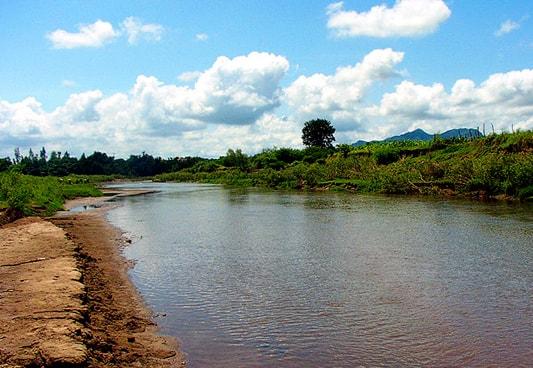
Rio Fuerte at Low Flow
Map 2 in "Mocorito y San Benito ... authored by
Raquel Padilla Ramos y Gilberto López Castillo.
The Land of 11 Rivers Trail Segment
El Camino a la Tierra Afuera
Leaving the foothills of Sonora and its tropical deciduous forests, Kino enters the tropical coastal plains of Sinaloa -"The Land of 11 Rivers." The El Camino Real de la Costa is squeezed between the Sierra Madre and the Gulf of California. Kino fords Sinaloa's 3 major rivers at low winter flows - not at summer torrents. Week 3 Route (December 1 to 6,1695): From Alamos down the Río Cuchujaqui to the ford across the Río Fuerte to Villa El Fuerte de Montesclaros; overland to Missions at Tehueco & Ocoroni; to Villa San Felipe y Santiago (Sinaloa de Leyva) and to the ford across the Petalán (Sinaloa) River; overland to Mission at Bamoa - cabacera of Nio; and to Mission at Mocoritos; crossing the Culicán River to Culicán - see additional Week 3 post entitled "Advocating Jesuit Return to Baja"
Kino begins the El Camino a la Tierra Afuera that runs from Sinaloa to Guadaljara and Mexico City.
Week 4 Trail
December 5, 2018 ·
Southern Sinaloa
Week 4
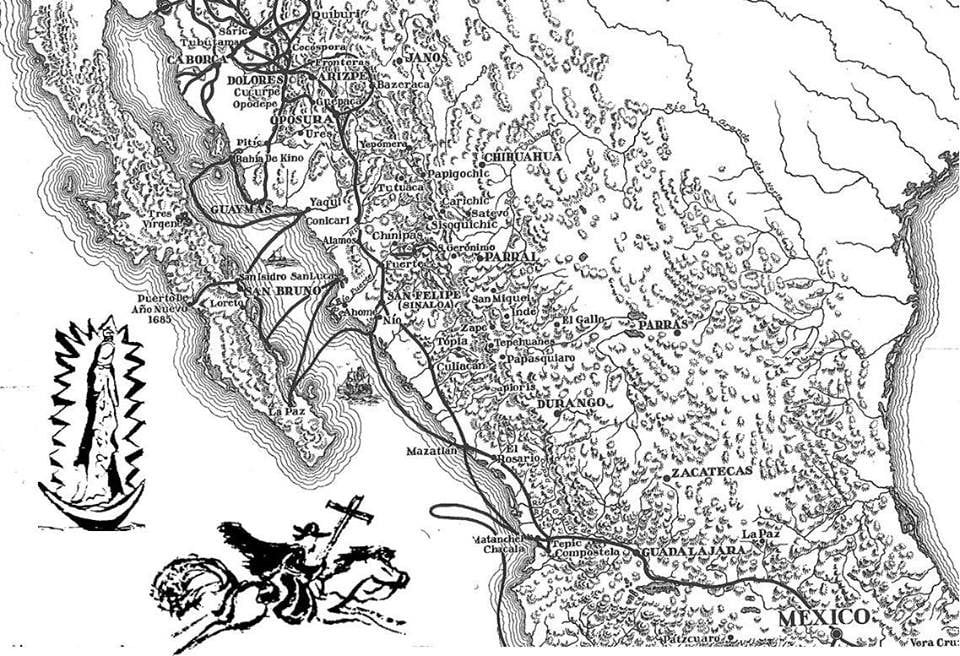
Bolton's Kino Travels Map and Drawings by Ted DeGrazia
Kino's Promise: Dedicating His Life To Our Lady of Guadalupe
Protector of Native People
Kino is on horseback riding the El Camino de la Costa on December 12, 1695 - the Feast Day of Our Lady of Guadalupe. He is half way on his ride of 1,500 miles (2,400 kilometers) and 53 days to the Mexico City capital from Mission Dolores. Kino promised Our Lady that he would dedicate the rest of his life as a missionary to Our Lady as the Protector of Native People. Working for justice, Kino appears before the highest Spanish authorities and defends the O'odham people of the Tubutama Uprising so that the peace and goodwill that he brought to the Pimeria Alta will be honored and will prevail. Kino - Missionary Guadalupano at http://padrekino.com/kino-legacy/missionary/
Week 4 Account
December 11, 2018 ·
Pacific Ocean Coast near Mazatlan
El Rosario, Sinaloa
Where Mountains Meet the Sea Trail Segment
Kino rides out of Culicán on the El Camino Real de la Costa that is still familiar to him after 11 years when his pioneering work in Baja California ended. At week's end, he will reach the rich silver mining town of El Real de Rosario after riding through the nascent seaport of Mazatlan. In subtropical Sinaloa the fastest route of the El Camino is on the narrow coastal plain between the Gulf of California and the Sierra Madre mountains. Today's Highway Mexico 15 follows the route. Week 4 Route of December 7 to 13, 1695: From Culicán southeasterly paralleling the Pacific coast to: San Lorenzo de Tabala, Elota, Camino Real de Piastla, Mazatlan and El Real de Rosario. Rosario is located 5 miles east of the endangered mangrove wetlands of Laguna del Caimanero.
Week 4 Trail
December 11, 2018 ·
Southern Sinaloa and Nayarit
Week 5
Sea of Cortez & El Gigante Mountains near Kino's San Bruno
Seafaring Kino: The Padre Under Sail
December 14 to 21,1695. Kino's history & that of the El Camino de la Costa must include Mexico's seafaring history in the Pacific Ocean. Kino sailed with Atondo from Chacala near Compostela beginning his first mission post in Baja. He crisscrossed the Sea of Cortez to and from Baja and the mainland collecting supplies for Baja. While waiting 50 days for favorable winds near Tiburon Island, Kino ministered to the Seri people. Later the Spanish return to Baja was ended when Kino's ship was diverted to warn a Manilla galleon of nearby Pichilingues pirates & to escort it to Acapulco. The pirates destroyed Pacific ports before being captured. In prison ministry in Mexico City, Kino worked with the captured pirates. Kino appealed to the King to reduce their sentences.
Week 5 Account
December 16, 2018 ·
Marismas Nacionales, Novillero Beach, Sangangüey Stratovolcano
The Tropical Pacific Coast To Central Highlands Trail Segment
From El Rosario Kino continues his ride on the El Camino Real de la Costa along its lagoons & mangrove wetlands (Marismas Nacionales - San Blas). Kino's destination this week is Compostela - the staging area of the Spanish explorations by land and sea to the Northwest - where Cortez, Coronado, Atondo & Anza first assembled and Cabeza de Vaca returned overland from Florida. Week 5 Route of December 13 to 20, 1695: From El Rosario to Escuinapa; continuing on the coastal plain through summer's often impassable camino section between Acaponeta and Santiago Ixcuintla - west is Mexico's longest beach - the 50 mile long Novillero Beach near Tecuala; steeply climbing 3,000 feet (915 meters) on to the western end of the Trans-Mexican Volcanic Belt country to Tepic & Compostela.
Week 5 Trail
December 16, 2018 ·
Nayarit and Western Jalisco
Week 6
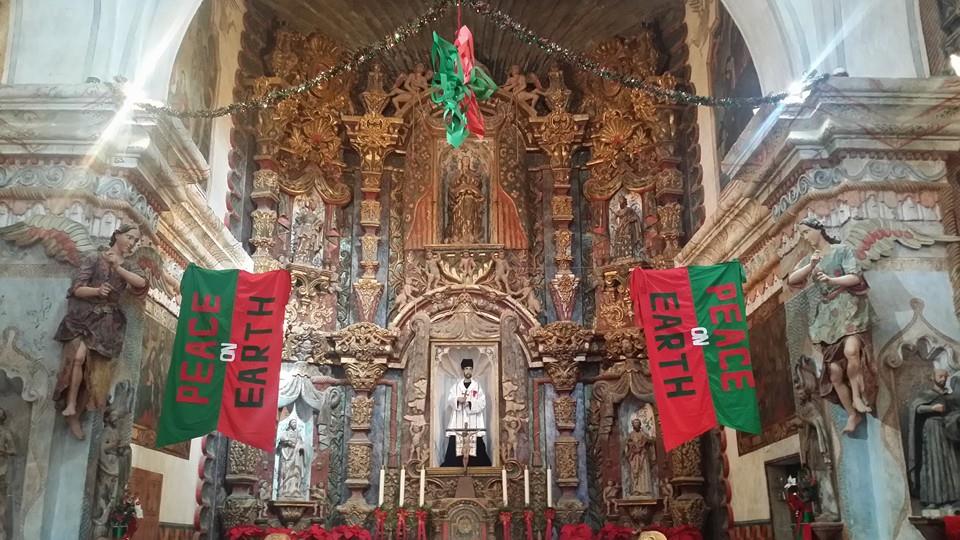
San Xavier del Bac in Tucson
Nuestra Señora de Loreto in Guadalajara
Nochebuena in Guadalajara
Kino and his O'odham trail companions arrive in Guadalajara on Christmas Eve after their ride from Compostela from December 14 to 24, 1695. Kino writes: "It was God's will that I should be able to say Mass every day of this journey; and the three masses of the Feast of the Nativity I said in the new church of Nuestra Señora de Loreto of Guadalaxara." After Christmas Day, Kino continues to Mexico City to bring his message of peace on Earth and justice for the Pimería Alta. He arrives during the Epiphany season and its celebrations of the coming of the Los Reyes Magos. Thank you Joel Smith - Photo: Christmas Eve at Mission San Xavier del Bac in the O'odham community of Wa:k. Let There Be Peace on Earth.
Week 6 Account
December 23, 2018
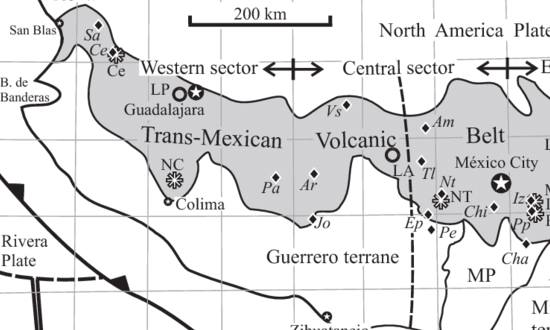
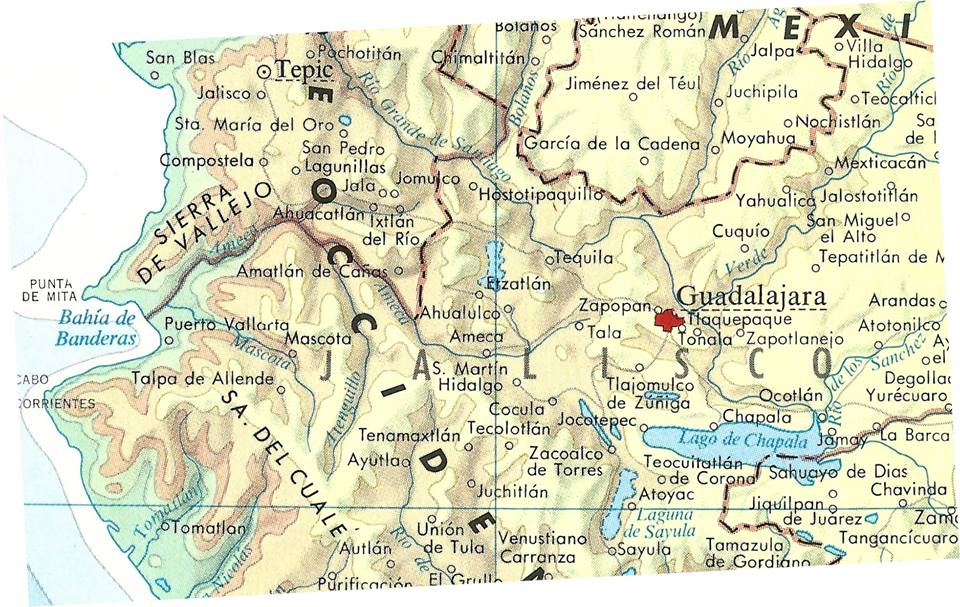
Central Highlands - Trans-Mexican Volcanic Belt
Río Grande de SantiagoTrail Segment
After riding south 900 miles in 30 days on the El Camino Real de la Costa, Kino now heads west from Compostela to Mexico City as he enters the Central Highlands (Trans-Mexican Volcanic Belt) - Mexico's heartland of towering volcanic mountains with forest clad slopes, fertile basins of shimmering blue lakes and vestiges of its indigenous empires. Week 6 and Nochebuena in Guadalajara - December 14 to 24, 1695: West from Compostela along the shores of Laguna San Pedro (via Highway 68D); then through the plateau rim that parallels the Río Grande de Santiago starting at Chapalila (via Highway 15); skirting the slopes of the Ceboruco stratovolcano to Ahauacantán; continuing on to Ixtlán del Rio (Ixtlán Ruins), Tequila, Zapopan & Guadalajara at 5,100 feet in elevation.
Week 6 Trail
December 23, 2018 ·
Eastern Jalisco, Michoacán and Guanajuato
Week 7
Salamanca and Lake Chapala, Mexico
Trento and Lake Garda, Italy
New Year in Salamanca: Memories of Home
Kino's journey to Mexico City on the El Camino Real is familiar. He shuttled back and forth between Mexico City and the Pacific seaports many times while working in Baja California and later advocating the return to it. He remembers other Christmas seasons on the trail - crossing Baja overland and visiting Tumacácori in today's Arizona. The snow blanketed volcanic peaks of the Sierra Nevada in the Central Highlands & the shimmering lakes and rivers stir memories of his Alpine home and his deceased parents and sister Margaherita and his two living sisters and their families. He will never return home to them in Trento. Photos clockwise from top left: In Mexico: Rio Lerma in Salamanca, & Lake Chapala; and in Italy: Lake Garda & Adige River in Trent. Week 7: December 26, 1695 to January 2, 1696.
Week 7 Account
December 29, 2018 ·
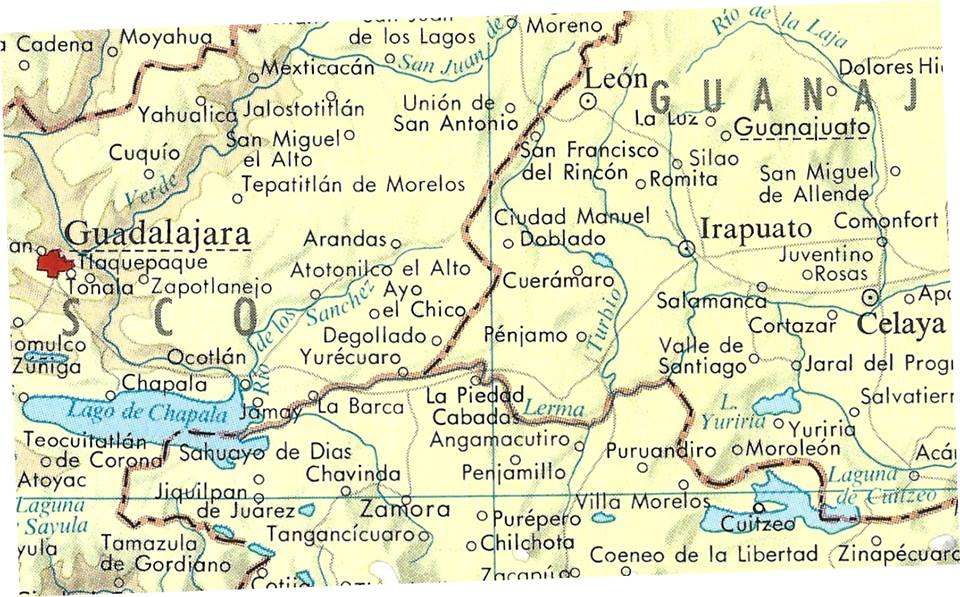
Cascada El Salto, Zona Arquealogica de Peralta, Salamanca
Río Lerma Trail Segment
To Salamanca following the Río Lerma - New Year. Kino leaves Guadalajara after Christmas & rides the El Camino Real through the Jalisco Basin, the Michoacán-Guanajuato Volcanic Field, and the Bajío plains following the course of the great Río Lerma that sustains the people of the Central Highlands. Week 7 Route - December 26, 1695 to January 2, 1696: From Guadalajara, following the Río Lerma southeast to Octolán on Lake Chapala; west to La Barca (Highway 15D) & Yurécuaro (Highway 114); Cascada El Salto, El Piedad. Leaving the Río Lerma, northeast along the foothills to Pénjamo, across the Río Turbio to Absolo (Highway 90); returning to the Río Lerma at the ruins at Peralta, the center of the Bajío cultural empire (300 - 900 CE) and to Salamanca.
Week 7 Trail
December 29, 2018 ·
Guanajuanto, Querétaro, Hidalgo, México & Distrito Federal
Week 8
"Father Kino - Defender of Indian Rights" commissioned by Shaw Kinsley
Our Lady of Guadalupe drawn by Fr. Eusebio Francisco Kino
Tepayac Hill: Our Lady of Guadalupe
Grieving for the dead of the Tubatama Uprising, Kino stops at Tepayac Hill after riding 1,500 miles in 53 days on the El Camino Real. He prays for the intercession of Our Lady of Guadalupe for the salvation of the dead of the Pimeria Alta & peace for the survivors. During the months that Kino worked temporarily in Mexico City, he would ride daily to Tepayac Hill in dedication to Our Lady of Guadalupe of his life and work as a missionary. Next Kino will speak truth to power to the highest authorities of New Spain in defense of the lives and rights of the O'odham people and other indigenous people and secure the peace that he brought to the Pimería Alta. Week 8, January 3 to 8, 1696. Destination - Valley of Mexico City on Día de los Reyes. More at http://padrekino.com/kino-legacy/ride-justice-and-peace/
Week 8
January 5 ·
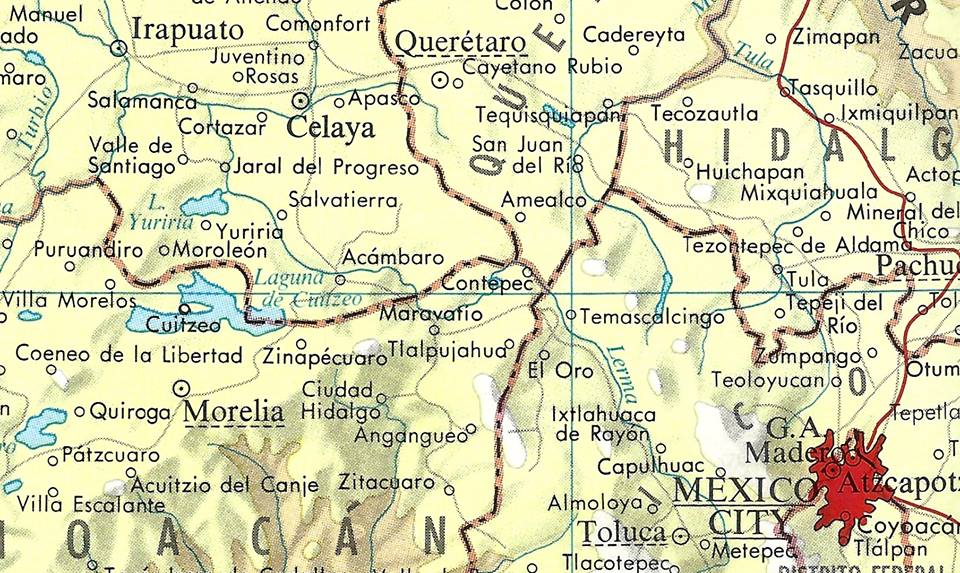
Puente de la Historia, San Juan del Río
El valle de México visto... by José María Velasco
Our Lady of Guadalupe by Nilda Alina Trevor Pino
Last Week Before Mexico City Arrival
El Camino Real de Tierra Adentro Trail
In the Mexico City capital Kino speaks truth to power in defense of the O'odham people and peace after riding 1,500 Miles in 53 Days. Week 8: Kino travels on the southmost segment of El Camino Real de Tierra Adentro Trail that runs between Mexico City to Santa Fe, New Mexico: January 3 to January 8, 1696: Via Highway 45: From Salamanca, Kino heads west along the Río Lara to Celaya and then along the Río Querétaro to Apasco and the crossroads of beautiful Santiago de Querétaro. Via Highway 57: heading south to San Juan del Río at the river ford - site of the Puente de la Historia; across the continental divide to Tula passing its Toltec empire ruins (900-1150 CE); Tepotzotlán and its 3 Jesuit colleges; over the lowest pass at 7,500 feet into the Valley of Mexico to Teoloyucan & Tepayac Hill of Our Lady of Guadalupe; Kino & the O'odham next generation arrive in Mexico City during the Día de los Tres Reyes Magos celebrations.
Week 8 Trail
January 5 ·
México City Capital
Weeks 9 Through 12
Speaking Truth to Power

Tepeyac Hill and Mexico City From "El Valle de México Visto ... "
by José María Velasco
"Archaeology at Fr. Eusebio Kino’s Headquarters, Dolores, Sonora"
by William K. Hartmann
Father Saeta Biography Presented
Dolores to Mexico City - Kino writes: "This year, 1695, however, in view of the very Christian truces which had been drawn up on the 30th of August in this Pimeria .... I determined, although some opposed me ... to go to Mexico for the good of so many souls in sore need; and so, setting out from these missions of Sonora on the 16th of November, 1695, in 7 weeks and after a journey of 500 leagues (2,400 km; 1,500 miles), I arrived at Mexico on January 8, 1696." Kino speaks truth to power. Kino defends the O'odham people as he presents to the authorities his biography of good Padre Saeta who was martyred. "[It] is evident that the treatment of the Natives in the Pimería has been very unjust — leading as it has to mistreatment, torture and murder." Mexico City. See http://padrekino.com/kino-legacy/ride-justice-and-peace/
Week 9 Account
January 8 ·
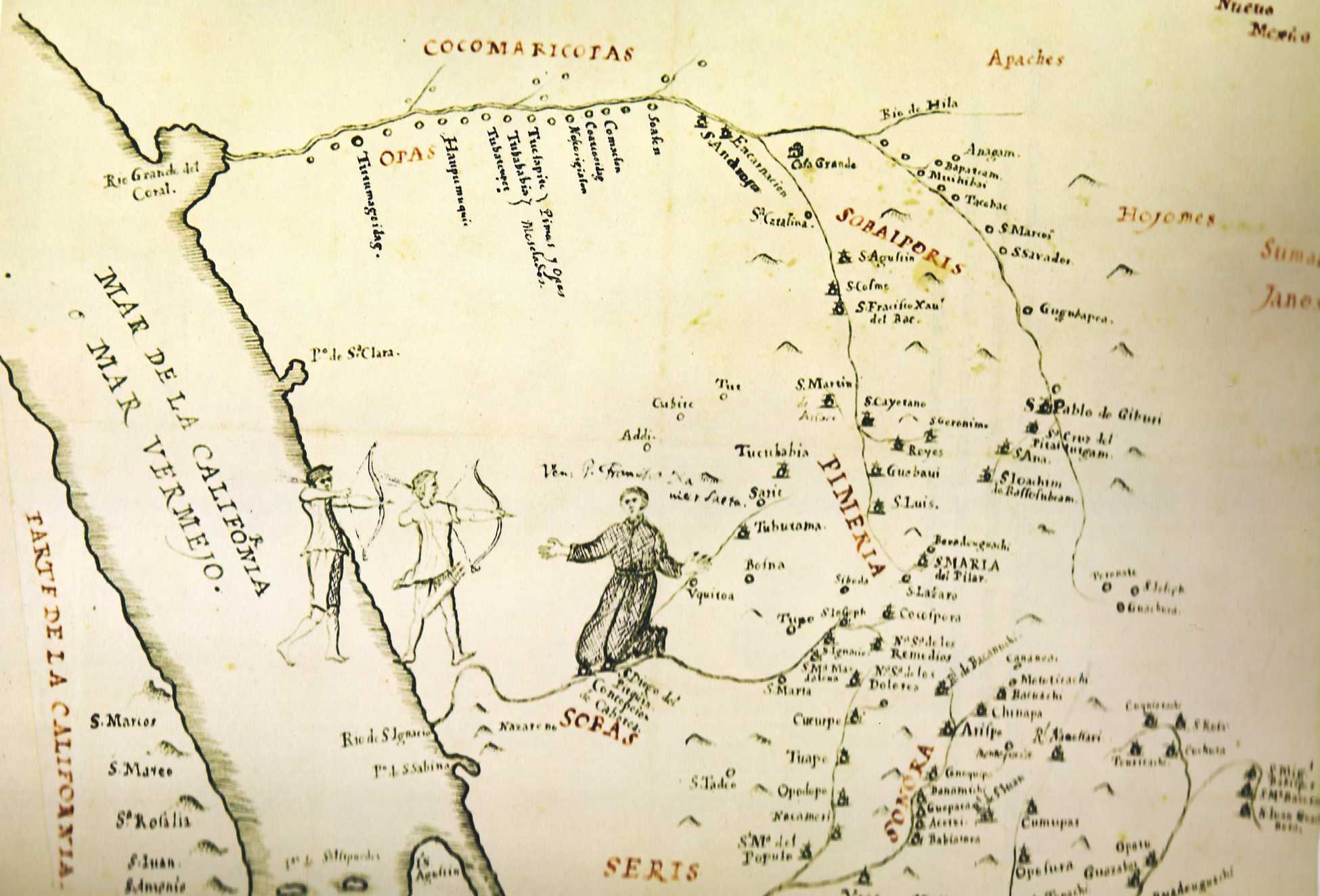
Kino's 1696 Map Illustrating His Saeta Biography
With Kino's Drawing of Father Saeta's Death
Defending the O'odham and Securing Peace
Kino writes that the history of murder and brutalization of the O'odham by certain Spanish commanders and their treachery at La Matanza provoked the uprising in the western Pimería. After Kino restored peace, the relentless opposition to him and his mission communities escalated and made its way again to the capital. Kino, a former teacher of rhetoric & communications, knew that a map is worth a 1,000 words. He drew new maps to add to the presentation in the capital of his Father Saeta Biography and its account of the senseless murders of the good priest and 80 innocent O'odham people. Kino's map depicts the martyrdom of Father Saeta from the arrows shot by 2 dignified warriors - bestowing heavenly blessings on the Pimeria. Kino's Saeta Map - Defending the O'odham and Securing Peace - Mexico City.
Week 10 Account
January 12 ·
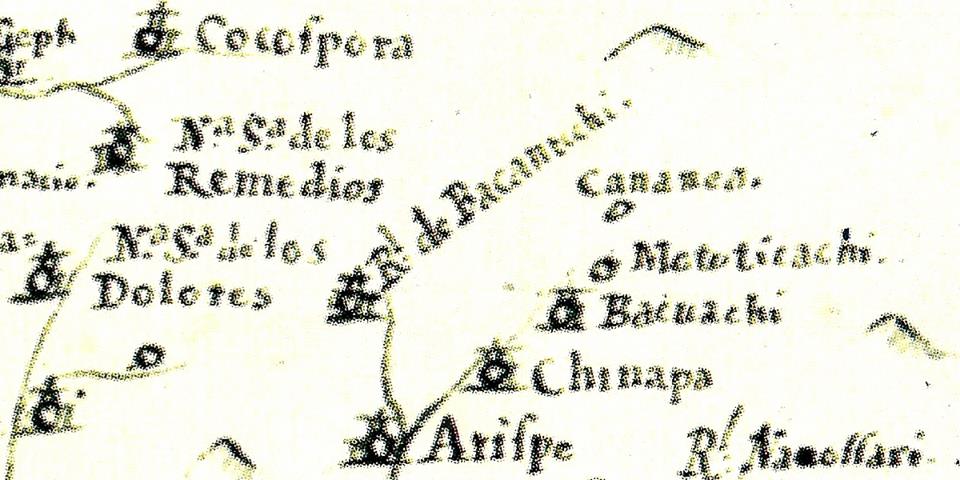

"Vista de la Plaza Mayor de la Ciudad de México" (1695) by Cristóbal de Villalpando
Detail of Kino's 1695 Map Illustrating His Saeta Biography
Restoring The Mototicachi O'odham To Their Land
Kino's Advocacy Restores O'odham People To Their Lands Ten Years after the Mototicachi Massacre. The immediate reason for Kino's ride to the Mexico capital was to secure the peace that he brought to end the military campaign against the O'odham in response to the Tubutama Revolt. Again Kino speaks truth to power about another incident of murder & brutalization that occurred 10 years earlier. Soon after Kino's arrival at Mission Dolores in 1687, the commander of Sinaloan troops ordered the destruction of the peaceful O'odham people living in Mototicachi, a village located 40 miles due east of Mission Dolores. All 50 adult males were murdered. All women & children were enslaved. Kino's advocacy results in an order from the viceroy restoring the surviving O'odham of Mototicachi to their lands. Mexico City.
Week 12
February 5 ·
Return To The Pimeria Alta
Riding The El Camino Real de la Costa

Kino and O'odham Trail Companions Leaving Mexico City
Section of City Hall Mural in Magdalena de Kino
Mexico City Rideout: O'odham Solidarity With Kino
O'odham Demonstration of Solidarity in Support of Kino On His Return. Kino rides out from Mexico City on February 8, 1696, knowing that the opposition to his work will continue from Spanish miners and ranchers and fellow Jesuits. Kino sends messages ahead to the O'odham Chieftans to meet at Mission Dolores when he returns in May. Kino needs a demonstration of solidarity in support of his work. Throughout the Pimería Alta, O'odham leaders travel to Dolores - some walking 250 miles from today's Phoenix, Arizona. In 1697 the O'odham travel further distances to march on Bazerac to show Kino's immediate superior their support. Later the Jesuits unite behind Kino after the Jesuit Father General in Rome writes that Kino's work is like that of missionary St. Francis Xavier. Magdalena Mural by Miguel Grijalva Arvizu.
Riding the El Camino Real to Mission Dolores
February 10 ·

Ride from Mission Dolores to Mexico City by Kino and O'odham Companions
Plot to End Kino's Missionary Career
The Fight Continues - Kino at Conicari during 1696 Holy Week & Easter. Kino's thoughts weigh heavily during his 3 month ride back from Mexico City. He prays for the souls of Padre Saeta & the 80 O'odham people who were slaughtered as a result of the Tubutama uprising & the Spanish response that began during last year's Holy Week. In Mexico City Kino secured the peace by his defense of the O'odham, however, he learned of the plot by Jesuit superiors to end his missionary career and return him to university teaching. Some Jesuits criticized Kino for his generosity in giving great amounts of food & clothing to the O'odham - Christian & non Christian. Kino sends messages to O'odham leaders to meet him at Mission Dolores to show solidarity for his work. More at http://padrekino.com/kino-legacy/ride-justice-and-peace/
April 21
Riding the El Camino Real to Mission Dolores


Maderan Sky Islands Mountain Map and Pima Land Map
Defending The O'odham in Bazeraca
Kino's Ride for Justice - Sonora's Maderan Mountain Sky Islands & La Serrena Rivers. Towards the end of his 3 month ride back from Mexico City, Kino takes a 90 mile side trip before he returns to his Dolores headquarters (located below "e" in mountain "La Madera"). He travels to Bazeraca at the base of the Sierra Madre Occidental (located right of "El Tigre" in the small valley just left of Chihuahua-Sonora border line). There Kino meets with his newly appointed superior, Visitor Polici, and continues speaking truth to power in defense of the O'odham people. Opposition to Kino increases and in October 1697, O'odham leaders as far as the Gila River march on Bazeraca to show solidarity & support for Kino. Thank you to Sky Jacobs for his maps. Facebook series on Kino's Mexico City journey is now online at http://padrekino.com/kino-legacy/mexico-journey/
May 5
Riding the El Camino Real to Mission Dolores
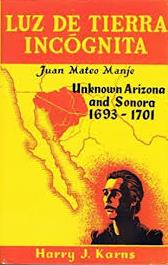
"Luz De Tierra Incógnita" by Juan Mateo Manje
Narrow Escape from Death
Ride for Justice - El Camino Real Dangers. Kino & his O'odham trail companions ride out of Baseraca with Captain Christóbal de León's party of 10. Kino leaves Christóbal to ride to Nácori near Bacadéhuachi to investigate another atrocity committed by Captain Sólis, the rogue commander of La Matanza. Next day Christóbal's party is killed in a Jocome ambush. Kino faced the same dangers on the El Camino to Mexico City. Banditry was so prevalent that the Viceroy will decree that bandits be punished by death. Kino wrote that he was completely safe traveling in O'odham lands that were unknown until his maps. Of Kino's 50 expeditions, 10 were with Captain Manje & 3 with more soldiers. Kino invited soldiers along to show them that the O'odham were allies. Home in a week. Manje accounts at http://padrekino.com/kino-legacy/ride-justice-and-peace/
May 11
Riding the El Camino Real to Mission Dolores

"Kino Ready for Trip"
Ettore "Ted" DeGrazia
Southwest Museum Kino-DeGrazia Exhibition 1962
Journey Ends But The Fight for Justice and Peace Continues
Kino Ride For Justice - Journey Ends But The Fight Continues - Mission Dolores Headquarters - Mid-May 1696. In Mexico City Kino defends the O'odham people and keeps the missions alive. On his return, Kino's fight for justice and peace continues against the relentless opposition by Spanish miners and ranchers. To counter the settler's campaign of vilification and attempts to provoke war between the O'odham and Spanish, Kino and the O'odham people support and protect each other. In one instance while Kino was away, the opposition led by a newly appointed Lieutenant drove with threats of death 90 O'odham people away from their Mission Dolores homes - all would return except one. The strong friendship and mutual trust between Kino and the O'odham maintains peace. Drawing by Ted DeGrazia. More at http://padrekino.com/kino-legacy/friend/
May 26
Riding the El Camino Real to Mission Dolores
Riding for Justice and Peace Continues - 1697
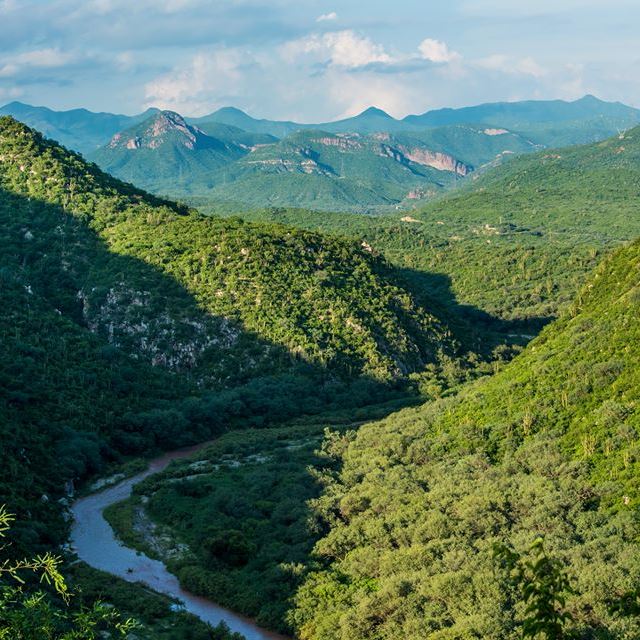
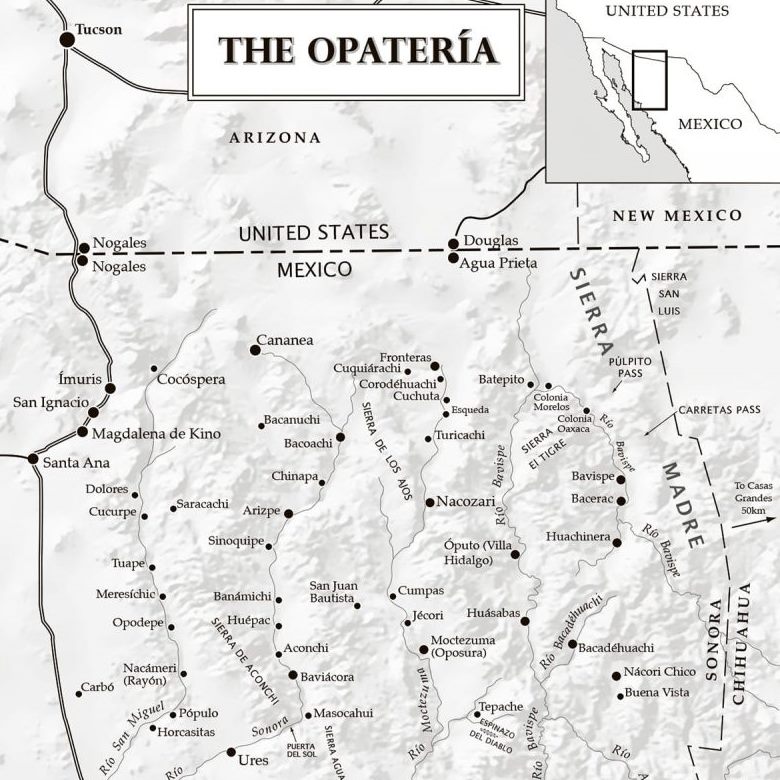
O'odham March On Bazerac Through Sky Island Mountains & La Serrena Rivers
"The Opateria" Map (Northern Half) Drawn By Paul Mirocha
Kino and O'odham March on Bazerac
Kino's Ride for Justice - O'odham Leaders March On Bazerac To Show Solidarity With Kino - October 6, 1697. Kino continues to speak truth to power in defense of the O'odham against colonists' campaign of false accusations that the O'odham raid & murder. Miners & ranchers try to provoke war for a pretext to kill & enslave the O'odham & steal their lands. In Bazerac the O'odham show the Father Visitor that they are Spanish allies. Kino provides safe passage in Opata lands, crossing 4 Sky Island mountains. Meeting at Dolores; through Tuape, Guépaca (today's Huepác), San Juan (colonial capital & mining center), Oposura (Moctezuma), Guasavas (Huásapas); to Bazerac. O'odham as far as the Gila River near Phoenix (more than 400 miles away from Bazerac) join with Kino to keep peace. More at http://padrekino.com/kino-legacy/ride-justice-and-peace/
October 5 at 5:57 PM
Riding for Justice and Peace Continues

Approaching Isla Danzante with the Sierra de la Gigante Arising from Baja's Coast
Parque Nacional Bahía de Loreto
Kino - The Founding Padre of Las Californias
Kino's Ride for Justice - October 19, 1697 - Salvatierra Restarts Jesuit Missions Beginning With Founding of Loreto - Kino's 12 Year California Dream Fullfilled - Work Continues. After Kino & Atondo were ordered to withdraw from Baja, Kino lobbied for the Jesuit return. Kino convinced Padre Juan María de Salvatierra, S.J. to join his cause on the Christmas 1692 first journey to Tumacacori. Both wrote letters to officials in Mexico City, Madrid & Rome. Kino personally lobbied during his 1696 month stay in Mexico City which Salvatierra continued on. Salvatierra sailed to Loreto to walk in Kino's Baja footsteps. Kino was to go with Salvatierra but his orders were changed as he rode to port. Kino remained on the Mexico mainland to supply the always precarious missions. More at http://padrekino.com/kino-legacy/pious-fund-california/
October 21 at 9:14 AM
Riding for Justice and Peace Continues
Reconstructed Daily Trail Log
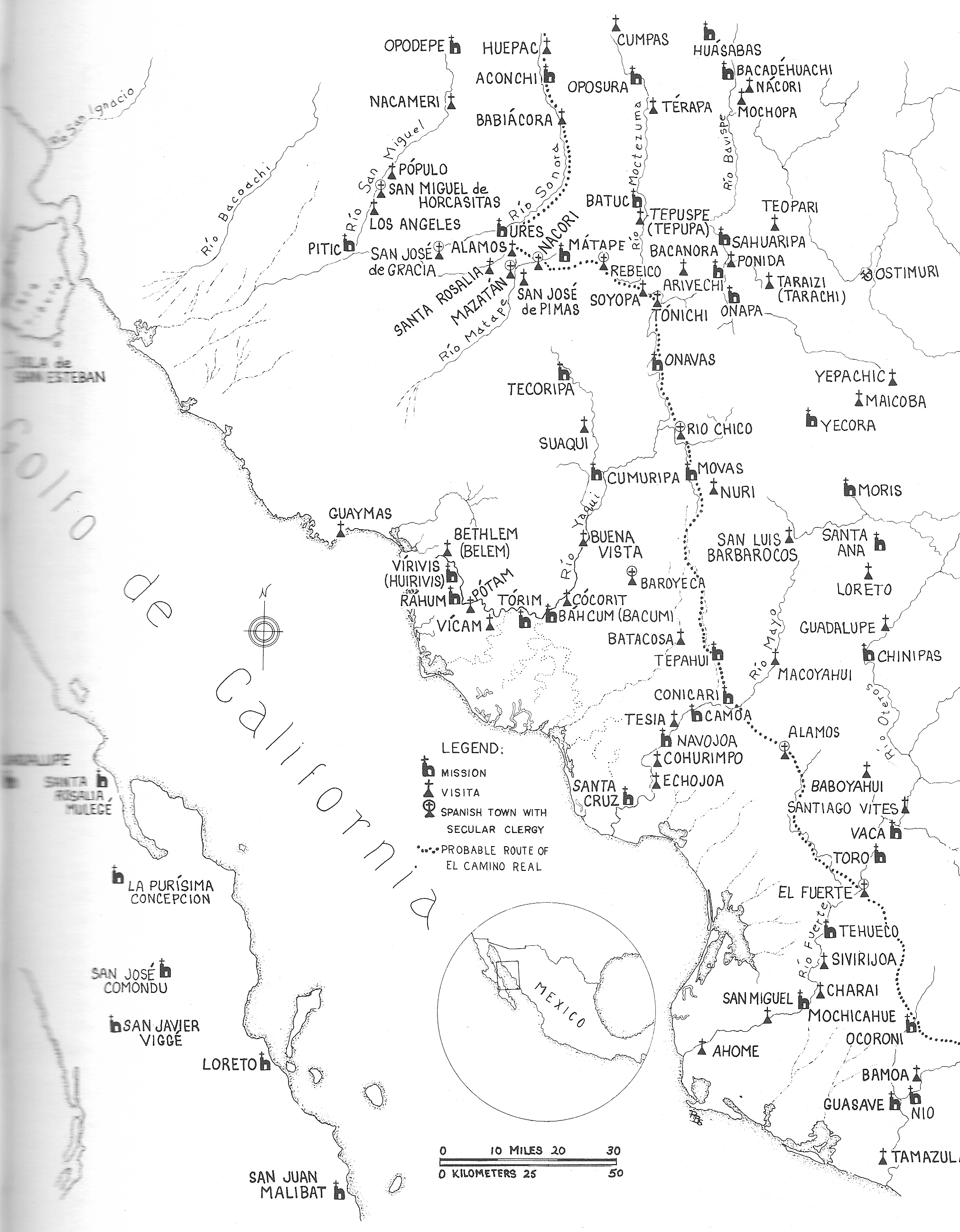
El Camino Real Map
"The Yaquis: A Cultural History" by author Edward H. Spicer
Reconstructed Daily Trail Log
Week Days Date Day Location Miles
1 0 16-Nov Sat Dolores Rideout ** 00
1 17-Nov Sun Curcupe 28
2 18-Nov Mon Huepac 56
3 19-Nov Tue S. Juan Bautista 84
4 20-Nov Wed Opusura 112
5 21-Nov Thu Batuc 140
6 22-Nov Fri Tepupa 168
2 7 23-Nov Sat San Miguel 196
8 24-Nov Sun Onavas 224
9 25-Nov Mon Nuri 252
10 26-Nov Tue Cedros 280
11 27-Nov Wed Betacose 308
12 28-Nov Thu Tepehui 336
13 29-Nov Fri Conicari 364
3 14 30-Nov Sat Alamos 392
15 1-Dec Sun El Fuerte 420
16 2-Dec Mon Tehueco 448
17 3-Dec Tue Ocoroni 476
18 4-Dec Wed Sinaloa 504
19 5-Dec Thu Bamboa 532
20 6-Dec Fri Mocoritos 560
4 21 7-Dec Sat Culican 588
22 8-Dec Sun San Lorenzo 616
23 9-Dec Mon . 644
24 10-Dec Tue Elota 672
25 11-Dec Wed Piastla 700
26 12-Dec Thu Mazatlan 728
27 13-Dec Fri Rosario 756
5 28 14-Dec Sat Acaponeta 784
29 15-Dec Sun Santiago Ixcuintla 812
30 16-Dec Mon . 840
31 17-Dec Tue Tepic 868
32 18-Dec Wed Compostela 896
33 19-Dec Thu Tetitlán 924
34 20-Dec Fri Ixtlan del Rio 952
6 35 21-Dec Sat Magdalena 980
36 22-Dec Sun Tequila 1008
37 23-Dec Mon Zapopan 1036
38 24-Dec Tue Guadalajara ** 1064
39 25-Dec Wed Octolán 1092
40 26-Dec Thu La Barca 1120
41 27-Dec Fri El Penjamo 1148
7 42 28-Dec Sat Absolo 1176
43 29-Dec Sun Salamanca 1204
44 30-Dec Mon Celaya 1232
45 31-Dec Tue Apasco 1260
46 1-Jan Wed Quetetaro 1288
47 2-Jan Thu San Juan del Rio 1316
48 3-Jan Fri . 1344
8 49 4-Jan Sat Tula 1372
50 5-Jan Sun Tepozotlan 1400
51 6-Jan Mon Teoloyucan 1428
52 7-Jan Tue Tepayac Hill 1456
53 8-Jan Wed Mexico City Arrival ** 1484
12 84 8-Feb Wed Mexico City Rideout **
17 105 25-Mar Sun Conicari **
?? ?? ?? ?? Baceraca **
?? ?? ?? ?? Nácori **
26 186 19-May ?? ?? Dolores Return **
Editor Note: Locations and date entries marked by asterisks ** are based on Kino's writings. The other dates at locations on the El Camino Real are conjectural. The article "Camino real de Sonora" by Flavio Molina sets out a log of a trip that was made in 1771 from Sonora to Mexico City The trip took twice the time that Kino's did.
Online Maps To Follow Kino's Ride
Online Maps
INEGI
Instituto Nacional de Estadística y Geografía
(The National Institute of Statistics and Geography)
For easy to use interactive map to follow Kino's ride, click
http://gaia.inegi.org.mx/mdm6/?v=bGF0OjMwLjQxOTY1LGxvbjotMTEwLjYyODE1LHo6NSxsOmMyMDA=
For entire INEGI Map Collection, click
https://www.inegi.org.mx/app/mapas/
History of Kino's Ride
For history of Tubatama Uprising, Kino's Ride and Its Aftermath
Click Page
Ride for Justice History Page
Father Baegert's 1750 Account
On The Camino Real
Herbert E. Bolton
No account of his long trek has come to us. But we do have the story of a similar missionary journey over almost precisely the same trail, the twelve hundred miles from the capital to the Mayo River. From this we are able to approximate the outlines of Kino's odyssey.
Years behind Kino, Father Jacob Baegert came to Mexico, went thence by land to Yaqui and from there crossed the Gulf to California. [1] As far as Conicari, places passed through and incidents of the trail were doubtless much the same for both travelers. Baegert's party was larger than Kino's and his pace was considerably slower. With nine other Jesuits Father Jacob left Mexico City on November 16. They had twelve servants and muleteers, mainly Indians, and twenty mules for mounts and to carry the baggage. Thus they made an impressive train. Passing through León, they reached Guadalajara |235| and continued through Tepic, Rosario, Culiacan, and San Felipe, reaching "Los Alamos or Los Frayles" on March 19, more than four months after leaving Mexico. On the west coast both Kino and Baegert probably passed also through Compostela, Mazatlán, and Fuerte. Coming from Mexico City on a Southern Pacific train today the traveler is close to the trail as far as Culiacán. There he leaves it at his right, for the old towns along the camino real, Mocorito, Sinaloa, Fuerte, and Alamos, and all the rest nearly to the Arizona line, were in the foothills or the mountains. There, and not along the railroad, is the ancient Camino Real. There is Old Mexico.
Baegert traveled "soldier fashion," from four to six hours a day, though sometimes eight or ten hours "in order to reach an inn, which means water for man and beast." His party went thus slowly in order to spare their animals for the long, hard journey. ...
Outside of the cities and towns most of their camps were in the open, with an occasional stop at some hacienda. At first the Jesuits slept on their mattresses in two tents. Beyond Tepic, where the hot country began, for protection against insects, scorpions, and snakes, each one slept in his own little tent, "which, supported by poles, was hung up lengthwise of the mattress and tucked well under it" to keep out vermin. The roads were rough, stony, mountainous, unimproved, and in most places mere mule trails; in fact "just as they were a year after the creation of the World." ...
"If all the cultivated land between Mexico and Hiaqui were put together," he said, "one could walk through it in an hour." Excepting the widely separated towns strung along the trail, from León forward the whole country was "a wilderness full of mountains but without forests, . . . |236|
The aridity of the terrain depressed him. Often they had to carry water from one camp to the next. "All the streams and stagnant water in the same stretch of country would not fill a river half the size of the Rhine. . . . Several times we drank from a hole which we dug in the sand of a river bed. . . . Often we drank from a ditch, or a cavity in a rock a yard and a half in width, where some of the previous year's rain still remained for the consolation of travelers, insects, and beasts. This was not to everyone's taste, but we managed to drink it and thanked Heaven for it." At another season, of course, where he now saw the dry sand of the stream bed, Baegert would have found roaring torrents. ...
For food Father Jacob had mostly sun-dried beef (tasajo or jerky) and tortillas, which he described for his German friends as "cakes made of Indian corn and warmed on a little piece of iron. . . . The so-called tamales are miserable stuff. .. . They are nothing but Indian corn dampened and grated, then rolled up again like an unshucked ear of corn, wrapped in some of the corn husks and eventually eaten. During our journey I was once obliged from stern necessity to eat this stuff for ten days." ....
"The streets and the floors of the houses differ in no way from the open fields. For windows they have only light holes, with a few bars across them as a protection against thieves and murderers but not against bats. . . . Nothing better than this is to be seen. It is not surprising to find such great and general poverty, |237| for the whole country has absolutely nothing to offer but a few unfortunate gold and silver mines." ... |238|
Herbert E. Bolton
"On The Camino Real"
Chapter 66
"Rim of Christendom:
A Biography of Eusebio Francisco Kino: Pacific Coast Pioneer"
Father Baegerts 1750 Account
Footnotes
[1] It was in 1750. The story of Baegert's journey is told by himself in a letter to his brother. September 11, 1752. "Brief eines Elsasser aus Californien in Nord Amerika an seinen Bruder in Schlettstadt, 1752, von Pater Jacob Bägert, d.G.J." Aus dem "Patriotischen Elsasser." Strassburg und Colmar. 1777.
For entire Bolton's Chapter 66, click
On the Camino Real 1750 document (text)
Baegert's Travels From Mexico City to Baja California
The Letters Of Jacob Baegert
September 11, 1752, click
Baegert From Mexico to Baja document (text)
Bandits on the El Camino Real
Ramón Eduardo Ruiz
Geographically, New Spain, in spite of three hundred years of colonial rule, was disunited; regionalism prevailed everywhere. One reason was the absence of roads. Passable ones going north from Mexico City could be found only because merchants, hacendados, mineowners, and, occasionally ayuntamientos built them. The transport of heavy or bulky goods was cost and slow, while travelers rode horse or mule or, if poor, walked. Bandits infested the routes, making travel risky and, at times, downright dangerous, and preyed on haciendas, mines, and towns. So bad was banditry that authorities believing stiff punishment a remedy, ordered, in 1699, that culprits caught lose a hand or foot; when that failed to stop them, a law passed in 1719 decreed the death penalty. Neither ended thievery.
Ramón Eduardo Ruiz
Triumphs and Tragedy: A History of the Mexican People 1992
More About The Camino Real de Sonora
"Camino real de Sonora"
Flavio Molina 1997, click
Camino real document (pdf)
"Morphology and Function of the Road Network of Eastern Sonora"
Richard Neil Dodge 1973, click →
https://repository.arizona.edu/handle/10150/555037
